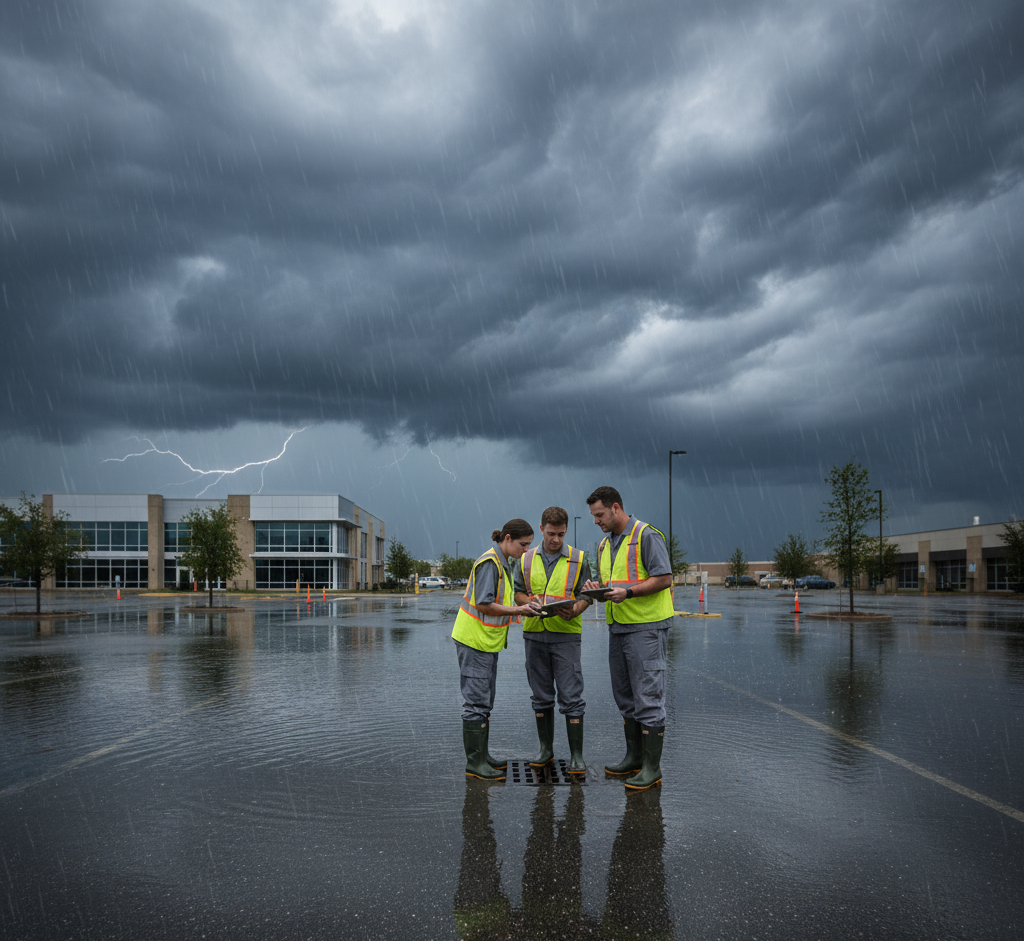Best Practices for Facility Managers in Northeast Ohio During Extreme Weather & Storm Recovery
When Weather Becomes a Facility Manager’s Test
Every storm that sweeps across Northeast Ohio tells a story — not just about the power of nature, but about how prepared our facilities truly are. Whether it’s the unpredictable snow squalls off Lake Erie, high winds toppling signage in downtown Cleveland, or sudden thunderstorms that flood parking lots in Akron and Canton, each event tests the strength, foresight, and adaptability of facility managers.
Over the past decade, Northeast Ohio’s climate has shifted in ways that have forced even the most seasoned facility teams to rethink their approach. Winters are becoming warmer but wetter, while summer storms now strike with a level of intensity that often overwhelms drainage systems.
The once-predictable freeze-thaw cycles have turned erratic, expanding cracks in roadways, loosening exterior façades, and straining HVAC systems designed for more stable conditions.
According to the NOAA Great Lakes Regional Climate Assessment, the region has seen a 20% increase in severe precipitation events since 2000, and the trend shows no signs of slowing. Counties such as Cuyahoga, Summit, and Lorain are feeling the effects through infrastructure fatigue, energy inefficiencies, and rising maintenance costs. The issue is no longer confined to seasonal maintenance — it’s a year-round operational challenge demanding strategic foresight.
For facility leaders, this isn’t just about reacting to what breaks; it’s about anticipating what might. It’s about implementing weather-resilient systems, conducting preventive inspections, and training teams to respond with precision when emergencies strike. At Immaculate Management Group (IMG), we’ve seen firsthand that weather readiness has evolved from a reactive duty into a core pillar of proactive facility strategy. Whether you manage a hospital, university campus, commercial plaza, or senior living facility, being prepared for nature’s unpredictability is no longer a competitive advantage — it’s a necessity for sustainability, safety, and long-term operational integrity.
The Growing Climate Challenge in Northeast Ohio
Northeast Ohio has long been known for its unpredictable weather, but what was once a regional quirk has become a genuine operational concern. Facility managers across Cleveland, Akron, Canton, and Youngstown are now confronting climate trends that no longer align with historical patterns. The once-reliable rhythms of the seasons — predictable winters, mild springs, and short, manageable summers — are being replaced by instability that strains both infrastructure and budgets.
According to the Ohio Environmental Council (OEC), the state has experienced a 2.5°F increase in average temperature since 1970, with the majority of that change occurring in just the past two decades. Warmer air holds more moisture, which directly contributes to the rising frequency of intense rainfall events that overwhelm stormwater systems and increase flood risks. For facilities built decades ago — especially those with aging drainage infrastructure or flat roofing systems — this is a ticking time bomb.
Another growing concern is freeze-thaw stress. The alternating cycles of freezing and warming temperatures cause expansion and contraction in concrete, asphalt, and metal components. In older facilities, this accelerates deterioration in roofing membranes, exterior walls, and walkways — often leading to expensive emergency repairs. Facility managers are finding themselves balancing between short-term patchwork and long-term resilience strategies, both of which require careful budgeting and operational foresight.
But the challenge goes beyond the physical infrastructure. Energy demand patterns are shifting too. Winters now bring more rain than snow, yet temperatures remain cold enough to keep heating systems running at high capacity. Summers are growing longer and hotter, driving up cooling costs. This dual strain pushes HVAC systems to their limits — forcing facility leaders to consider energy audits, smart building technologies, and even renewable power sources as part of a broader resilience plan.
These evolving conditions make it clear: weather isn’t just a maintenance concern — it’s a management issue that affects every department, from finance and procurement to safety and communications. The most successful facility managers in Northeast Ohio are those who approach climate challenges with a strategic mindset — one that aligns operational readiness with sustainability, efficiency, and community well-being.
How Facility Managers Can Build Weather-Ready Systems
Weather resilience doesn’t happen by chance — it’s engineered through foresight, planning, and consistent maintenance. For facility managers across Northeast Ohio, the goal isn’t just to respond to emergencies but to design systems and workflows that anticipate them. Every building, from a university dormitory in Kent to a medical center in Cleveland, can be made more resilient when the right strategies and technologies are in place.
1. Conduct Preventive Weather Assessments Year-Round
A successful resilience plan begins long before the first storm alert. Facility managers are increasingly performing quarterly preventive inspections rather than seasonal ones, paying special attention to roofing integrity, insulation, drainage systems, and outdoor electrical components. Using thermal imaging and moisture sensors, teams can identify water infiltration or insulation weaknesses before they evolve into costly damage.
Modern tools like drone inspections and AI-powered building monitoring platforms are now accessible even for mid-sized organizations. These technologies enable a more proactive approach — providing real-time data that helps prioritize maintenance, allocate resources, and even forecast risk during high-impact weather events.
2. Strengthen Communication and Response Protocols
In a crisis, communication speed can determine how much a facility loses or saves. A weather-ready facility relies on clear emergency response protocols, including updated contact lists for maintenance crews, utility providers, and safety personnel. Cloud-based management systems like HubSpot Operations Hub or FM:Systems allow facility leaders to synchronize updates across departments — ensuring everyone from janitorial teams to executive directors knows what to do and when.
Regular storm-readiness drills are also essential. Facilities that run these simulations at least twice a year are better equipped to handle power outages, flooding, or structural damage, according to recent findings from the International Facility Management Association (IFMA).
3. Upgrade to Climate-Resilient Infrastructure
As building codes evolve, resilience upgrades are no longer optional. Facilities in flood-prone areas of Summit and Lorain Counties, for example, are now investing in permeable pavement, rain gardens, and green roofing systems that naturally reduce runoff. Meanwhile, HVAC systems are being replaced with models designed to perform efficiently across fluctuating temperature ranges — an increasingly vital adaptation for facilities battling both cold snaps and heatwaves.
Some organizations are also leveraging federal and state incentive programs for energy efficiency upgrades. For instance, Ohio’s Energy Efficiency Resource Standard (EERS) encourages public and private facilities to implement solutions that lower energy consumption while enhancing sustainability.
4. Build Partnerships Before Disaster Strikes
One of the most overlooked elements of weather preparedness is partnership. Establishing relationships with local contractors, restoration companies, and facility service providers like Immaculate Management Group (IMG) before an emergency occurs ensures that critical repairs can begin immediately. IMG, for instance, offers rapid-response facility maintenance, storm recovery, and preventive asset management that help organizations minimize downtime and extend the lifespan of their infrastructure.
Proactive collaboration — not panic-driven outsourcing — defines the difference between a smooth recovery and a prolonged crisis.
5. Train Staff for Multi-Scenario Resilience
People, not just buildings, determine how effectively a facility weathers a storm. Managers should invest in ongoing training that equips custodial, maintenance, and administrative staff with practical skills such as first-response safety, equipment preservation, and data recovery procedures. The goal is to empower every team member to act confidently when disruption occurs.
A resilient facility culture starts with leadership. When teams see preparedness prioritized at the top level, they mirror that same discipline in their daily operations — creating a cycle of accountability and safety that extends well beyond a single season.
Lessons from Recent Storm Events in Northeast Ohio
Every major storm leaves behind more than property damage — it leaves lessons. Over the past five years, several weather events across Northeast Ohio have reshaped how facility managers think about preparedness, communication, and recovery. From the 2022 ice storm that crippled power grids to the 2024 summer floods that shut down commercial corridors in Cleveland, each incident underscores a single truth: resilience is built before disaster, not after.
1. The 2022 Ice Storm: Testing Power Redundancy
In February 2022, a severe ice storm blanketed parts of Cuyahoga and Summit Counties, bringing down power lines and immobilizing critical services. Hospitals, nursing facilities, and retail centers struggled to maintain operations as power outages lasted for days. Facilities that had invested in backup generators and fuel supply partnerships fared significantly better than those relying solely on the grid.
At Immaculate Management Group (IMG), we observed that clients who maintained quarterly generator load tests and emergency energy audits were able to stay partially operational during the outage. The event reinforced an essential facility truth: redundancy is not a luxury — it’s insurance against chaos.
2. The 2023 Flash Floods: Drainage Systems Under Siege
In June 2023, torrential rainfall overwhelmed stormwater infrastructure in Akron, Lorain, and Medina, flooding basements, garages, and ground-level commercial spaces. Many facilities discovered too late that their drainage systems had not been inspected or cleaned in years. Even buildings located outside FEMA flood zones experienced water damage due to blocked roof drains and overwhelmed sump pumps.
For proactive facility managers, this was a wake-up call. Routine gutter and catch-basin maintenance emerged as one of the simplest yet most cost-effective defenses against catastrophic flooding. Following the floods, several municipalities implemented stricter inspection schedules for both public and private properties — a move that reflects how climate shifts are changing regulatory expectations.
3. The 2024 Heatwave and HVAC Failures
Summer 2024 brought record-breaking heat across Northeast Ohio, pushing many HVAC systems beyond their operational limits. Hospitals and schools with older systems faced the dual challenge of maintaining air quality and preventing system breakdowns during peak demand. In several instances, facilities with smart thermostats and predictive maintenance software were able to monitor temperature spikes in real time and trigger automatic system adjustments, avoiding downtime.
This event emphasized the importance of data-driven maintenance — an approach where analytics, rather than intuition, guide decision-making. Facility leaders now recognize that investing in technology today prevents costly shutdowns tomorrow.
4. The 2025 Early Storm Warnings: Communication Is Everything
This year’s early autumn storm warnings demonstrated another critical insight: the importance of cross-department communication. Facilities that had centralized communication hubs — where maintenance, security, and leadership teams could share updates instantly — reacted faster to safety threats. Conversely, sites using fragmented communication methods (emails, phone chains, or ad hoc messages) suffered delays that increased risk and confusion.
At IMG, we encourage facility leaders to adopt cloud-based facility management dashboards that centralize emergency protocols, contact lists, and action logs. These tools don’t just streamline communication; they preserve accountability and create transparency during post-event reviews.
Key Takeaway
Each storm reinforces that weather resilience isn’t a project — it’s a continuous mindset. Preparedness must be woven into a facility’s DNA, from leadership policies to frontline actions. For Northeast Ohio, where weather extremes have become the norm, success depends on how well facility managers translate experience into evolution.
Building a Resilience Culture: Leadership, People, and Preparedness
True resilience begins long before a weather alert is issued — it starts with leadership. A well-prepared facility isn’t simply defined by strong infrastructure or modern systems; it’s defined by the mindset of the people who operate it. In Northeast Ohio, where facility teams face unpredictable storms, fluctuating temperatures, and aging assets, leaders must build a resilience culture that prioritizes communication, accountability, and adaptability at every level.
1. Leadership That Models Preparedness
Facility management leadership sets the tone for how seriously a team approaches readiness. When managers treat weather planning as a strategic priority — not just an operational duty — teams follow suit. This means allocating budget for preventive maintenance, investing in emergency response training, and setting measurable resilience KPIs such as response times, recovery duration, and equipment uptime.
At Immaculate Management Group (IMG), our experience shows that leadership engagement directly influences how quickly and effectively teams respond during crises. Facility directors who participate in walkthroughs, safety meetings, and post-storm reviews create a culture of transparency and shared responsibility. It’s not about micromanagement — it’s about visibility and unity under pressure.
2. Empowering Frontline Teams
Frontline staff — technicians, janitors, groundskeepers, and security personnel — are often the first to see the warning signs of a potential issue. Whether it’s a clogged drain before a storm or a power fluctuation during an outage, their observations are critical. Empowering these individuals means more than giving instructions; it means training them to act decisively, report efficiently, and take ownership of their roles in the resilience chain.
Creating a “See It, Solve It, Share It” mindset encourages team members to proactively identify and address problems before they escalate. This hands-on empowerment turns reactive maintenance into predictive management, saving time, money, and — most importantly — reputation.
3. Strengthening Communication Across Departments
Resilience depends on coordination. Facilities that thrive during extreme weather typically maintain cross-departmental communication frameworks that connect maintenance, administration, IT, and safety teams. These communication loops should operate both vertically (management-to-staff) and horizontally (team-to-team).
Many leading facility organizations in Northeast Ohio now use digital dashboards and cloud-based response platforms to track issues in real time. These tools not only streamline emergency communication but also build institutional memory — helping teams analyze responses and refine protocols after each incident.
At IMG, we’ve found that clear, consistent communication during crisis scenarios cuts operational downtime by as much as 35%, a figure supported by recent IFMA benchmarking reports.
4. Continuous Learning and Simulation
A resilience culture is sustained through learning. Regular post-storm debriefs, simulation exercises, and training workshops help teams remain sharp and confident. Simulations can range from mock flood response drills to power outage scenarios — all designed to ensure that every employee knows their exact role during real emergencies.
The most effective facilities make these exercises part of their organizational rhythm rather than an annual obligation. They integrate weather analytics, review incident reports, and update their emergency playbooks frequently to align with changing climate realities.
5. Recognizing and Rewarding Preparedness
Finally, resilience should be celebrated. Recognizing staff who contribute to weather-readiness — through quick thinking, preventive actions, or effective communication — reinforces a positive culture. Incentives don’t have to be financial; acknowledgment in staff meetings, digital badges, or professional development opportunities can go a long way toward building morale and engagement.
A culture that rewards preparation naturally breeds consistency. When every team member sees that resilience is valued, they begin to internalize it as part of their professional identity — and that’s what makes the difference between recovery and resilience.
Beyond the Storm: Redefining Facility Management for the Future
As the climate continues to evolve, so must the philosophy of facility management. The storms that batter Northeast Ohio are no longer isolated weather events — they’re indicators of a broader shift that demands a new era of leadership, innovation, and accountability. For facility managers, this means embracing resilience not just as a response strategy but as a core value embedded in every operational decision.
The future of facility management will be defined by data-driven insight, predictive technology, and sustainable infrastructure. Smart systems that monitor energy use, detect leaks, or predict HVAC failures are already transforming how managers approach maintenance. However, technology alone isn’t the solution — it’s the human element that determines whether these tools achieve their full potential. Teams that communicate effectively, adapt quickly, and plan collaboratively will always outperform those that rely on reaction over preparation.
For Northeast Ohio, where weather extremes are becoming both more frequent and more severe, the ability to integrate resilience into daily facility operations will determine not just performance but survival. From university campuses in Kent and Oberlin to medical centers in Cleveland and Akron, every facility’s success will depend on how effectively it prepares for the unexpected.
At Immaculate Management Group (IMG), we believe that resilient facility management is proactive facility management. Our work with organizations across education, healthcare, and commercial sectors has shown that preparedness doesn’t just prevent losses — it builds trust, protects reputations, and extends the life of assets. By combining preventive maintenance, rapid-response capability, and data-backed strategy, we help clients face every storm with confidence.
In the end, weather is unpredictable — but preparation is not. The next major storm in Northeast Ohio will come, as it always does. The question for facility leaders is: Will your building withstand it, or will it be caught unprepared?
The answer depends on the choices you make today.
Is your facility prepared for Northeast Ohio’s next storm?
Partner with Immaculate Management Group (IMG) for proactive maintenance, rapid-response recovery, and facility solutions built to withstand whatever nature delivers.



